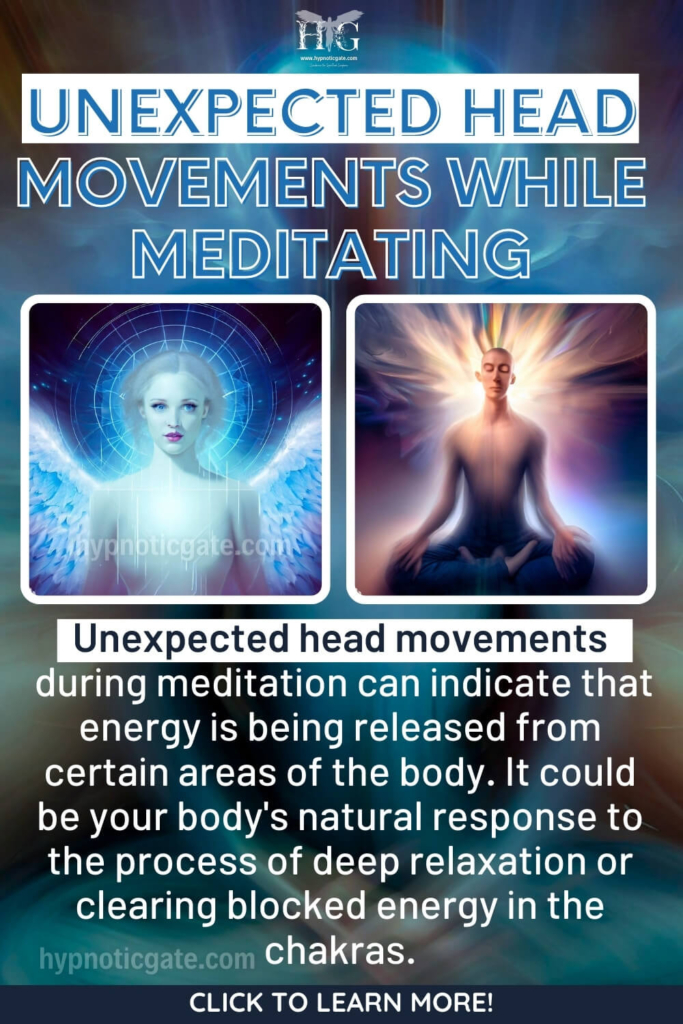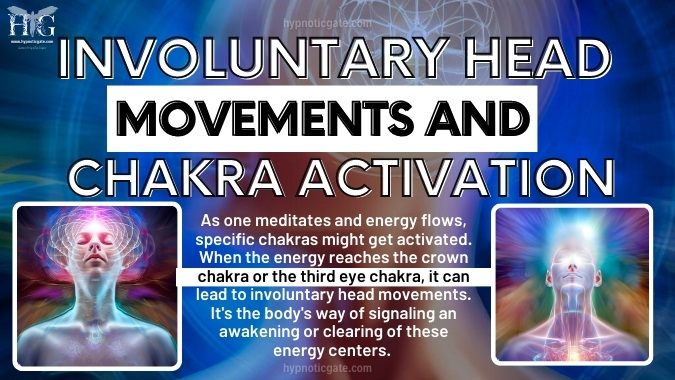
Greetings! This is our newest piece on Hypnoticgate.com. We’re focusing on unexpected head motions in meditation. We meditate for tranquility and concentration, but pesky shifts or sensations can pop up in our bodies. Why is this happening? Does it have to do with prana or qi energy? In this article, let’s dissect why our heads move unexpectedly during meditation and how to combat these movements. This will help make your meditation time better. Ready? Let’s begin!
What Factors May Contribute To Involuntary Head Movements During Meditation?

Let’s check some valid things that might be reasons why you have experienced involuntary head movement while in meditation:
- Chi energy or qi energy: According to traditional Chinese medicine, the flow of chi energy through the body’s meridians can be disrupted by blockages or imbalances, leading to physical sensations or movements.
- Chakra imbalances: In some spiritual traditions, it is believed that imbalances in the body’s chakra energy centers can manifest as physical symptoms, including involuntary head movements.
- Meridians: Similar to the concept of chi energy, the body’s meridians are believed to be channels through which energy flows. Blockages or imbalances in these channels may cause physical sensations or movements.
- Nervous system: The nervous system controls muscle movement and reflexes. Dysregulation of the nervous system due to stress or other factors may cause involuntary head movements during meditation.
- Sitting position: Poor posture or discomfort in the sitting position may contribute to involuntary head movements.
- Breathing position: How we position and move our head and neck during breathing can also affect involuntary head movements.
- Stress level: High levels of stress or tension may cause involuntary head movements as a way for the body to release pent-up energy.
- Amygdala: The amygdala, a part of the brain involved in the body’s stress response, may play a role in involuntary head movements during meditation.
Meridians are like rivers flowing through the body to irrigate and nourish the tissues. The flow of qi through the meridians can be disrupted by stress, poor diet, and/or excessive or insufficient exercise, leading to a decline in physical and emotional health.”
– Tzu-tsai Liu
Emotional Release Might Be

Head movements while meditating might come from old emotions suddenly coming to the surface. This might be due to deep-seated past issues or blocked emotional pathways.
Meditating helps our subconscious mind open up, making it easier for hidden feelings to rise up and cause physical reactions or movements. Changes in our brain’s wave patterns when we meditate could also help let loose these feelings and deal with unsettled matters. Being aware of ourselves and boosting our emotional smarts lets us see the ties between our feelings and physical happenings, like the automatic head movements we might have while meditating.
Related: Meditation as a Tool for Problem-Solving and Growth
“Shaking is a natural healing response of the body to discharge tension and restore balance. It is the body’s way of saying, ‘I don’t want to hold on to this anymore.'”
– David Berceli
How Can We Recognize Emotions Causing Involuntary Head Movements in Meditation?
- Observe physical sensations: Pay attention to trends linked to involuntary head movements, such as tension, tightness, or feelings of release. These can reveal the emotions causing the signs.
- Assess your emotional state: Before and during meditation, evaluate your emotions. Feeling overwhelmed, anxious, or stressed may trigger physical sensations or movements while meditating.
- Track patterns: Notice if specific situations or emotions consistently lead to involuntary head movements during meditation. Identifying patterns can help you understand the feelings behind these movements.
Observe how your body feels: Pay close attention to what you feel when your head moves involuntarily – like feeling tense, experiencing tightness, or a sense of relief. These feelings can offer hints about the hidden emotions that trigger these movements.
Related: How You Might Feel After Meditating?
Why Do I Have Involuntary Movement During Meditation?
Your kundalini or qi energy can awaken at times. This can lead to movement during meditation–a thing known in India as kriyas. Movements might be small, like a light sway.
Or they could be big, like movements seen in seizures. This can also happen in energy meditation on a smaller scale. Some people experience kriyas each time they meditate. Others might only have them once in a while. But it’s important to pay attention to these movements. It matters to treat these movements with kindness to ourselves and an open mind as they could be a normal part of a spiritual awakening or self-discovery.
Managing Involuntary Movements During Meditation:

- Be open-minded: Approach involuntary movements with self-compassion and an open mind, as they may be a natural part of spiritual awakening and self-exploration, as well as release tension from the body.
- Focus on your breath: If movements are distracting, try concentrating to return your focus to the present moment.
- Experiment with different techniques: Try various meditation practices, such as mindful breathing or loving-kindness meditation, to find what works best for managing emotions and involuntary movements.
- Be patient: Understand that kriyas or involuntary movements may occur periodically or with varying intensity. Be patient with yourself, and remember that your meditation practice is a personal journey.
Imagine you focus on a motion and it gets you agitated. You could explore various meditation methods like conscious breathing or love-kindness meditation. Check if these techniques better help control your feelings and unintentional actions.
Related: 5 Techniques to Cultivate and Harness “Chi Energy”
Are Involuntary Head Movements During Meditation Normal?
Many individuals may experience involuntary head movements during meditation called kriyas. It’s seen as part of the spiritual growth road, helping discover yourself and clear energy blocks. There can be several reasons behind kriyas, like physical discomfort or medical issues. It could also be due to tension release or blocked energy freeing up. Some people might experience kriyas every time they meditate; others may seldom or never have them.
Is It Possible To Eliminate Involuntary Head Movements During Meditation?
Meditating often ends up with involuntary head movements. Pay attention to your breathing or one thought to lessen this. This generally works well. But complete control of these movements may be challenging. Issues like stress, discomfort, or excess energy could be the reason.
If these head movements happen a lot during meditation, try something new. Love-centric meditation can help manage emotions, while Taoist inner-smile meditation is great for beginners. Other mindfulness exercises could also work. It’s also key to notice sensations on your head’s top, this can hint what is causing these movements and how to manage them.
Why Does My Head Vibrate When I Meditate?
Does your scalp tingle during meditation? Don’t worry! This is often ordinary, especially if you’re new at it.
One potential reason could be the movement of chi (qi) energy, or prana, as yogis say. This rush of life force can travel within your body, showing up as tingles or vibrations.
But there may be other reasons too, like a ringing noise in your ears. This can be due to stress, age-related hearing decline, or loud sounds. Alternatively, you might feel a rising energy towards your top chakra. This is tied to enlightenment and spiritual ties. You may feel this when you concentrate inward and tune into your inner emotions during your meditation.
Related: Exploring the Possibility of Jesus Suffering from Anxiety
Using Somatic Experiencing to Process and Release Trauma
If your body shakes while you’re meditating, don’t worry. This could be your body’s way of letting go of past distress. This is part of what’s known as “Somatic experiencing.” This was created by Dr. Peter Levine. It’s aimed at helping people deal with and let go of trauma.
So, how does it function? You focus on your body’s physical feelings. You might shake or tremble. This could help to get rid of any built-up stress and make your nervous system calmer. If you feel something at the top of your head when you meditate, it could be your body trying to get rid of stress or trauma through these healing shakes.
“Shaking is the body’s natural way of releasing and discharging pent-up energy and tension. It is a powerful way to regulate the nervous system and restore balance to the body and mind.”
– Peter Levine
Can Too Much Meditation Be Harmful?
Many people hold the view that overdosing on meditation isn’t necessarily a bad thing. The more they do it, the more they feel its goodness. But, if you’re just starting with meditation, take it easy. Why? Your nerves might need more time to cope. As you start to meditate regularly, shifts in your body, energy, and life force (prana) might happen.
So, it’s crucial to take it slow and let yourself adapt. Your spiritual core, and nerve system need their sweet time to meet the fresh demands of meditation. Thus, start at a slow pace, build up your practice slowly. Let your body and mind mend and adapt with your progress. Be patient, stay consistent in your practice, and you’ll soon realize that meditation is a mighty ally for health and self-learning.
Hypnosis For Alternative Meditations
Do annoying, uncontrolled movements make you uneasy? Consider other forms of meditation! You might be unsure about trying spiritual methods like chakra meditation, but self-hypnosis could be just the ticket. It’s simple and worthwhile. Self-hypnosis helps you reach a super relaxed state perfect for meditation and self-discovery. It’s all about guiding yourself into a hypnotic state. Often, this is done through imagining scenes or relaxing your muscles, which can further aid in relaxation.
Also, the brain produces theta waves associated with relaxation and a sense of calm in the hypnotic state. The good news is that you can listen to the high-quality hypnosis audio and try it yourself.
| Benefit | Meditation | Hypnosis |
|---|---|---|
| Stress and anxiety relief | Yes | Yes |
| Improved focus and concentration | Yes | Yes |
| Increased self-awareness | Yes | Yes |
| Improved sleep | Yes | Yes |
| Improved physical and emotional well-being | Yes | Yes |
| Increased creativity and problem-solving skills | Yes | Yes |
| Increased relaxation and calmness | Yes | Yes |
| Access to the unconscious mind | Yes | Yes |
| Theta brain wave activation | Yes | Yes |
| Requires a guide | No | Yes |
Though hypnosis often demands guidance, meditation can be self-led if you’ve got the knack. Both practices can spark theta brain waves. These waves link us to deep chill-out time, our inner thoughts, and creative vibes.
How Does Prana Relate to Involuntary Head Movements?
When meditating, people try to connect with this prana. They let it travel unblocked in the body. At times, this energy boost may show as uncontrollable movements. As prana shifts and removes obstructions, the head may twitch on its own. Consider it like the body getting used to the stronger energy flow.
Conclusion
This piece explores why people might deal with involuntary head movements when meditating. Plus, it shares useful suggestions to tackle this issue, improving your meditation routine. Truth be told, it’s a thing most people encounter and it’s nothing to fear. Still, switching up your meditation style might be helpful if it starts to bug you.
Suggestion:

